Closing the gap from farm to food bank
By Dee Reid
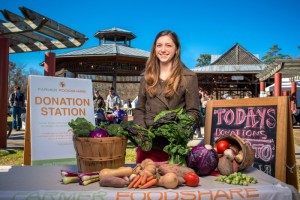
Farmer Foodshare Executive Director Gini Bell. Photo by Jerry Wolford/ Scott Muthersbough
North Carolina’s Triangle area has cultivated a foodie paradise of sustainable farms, growers’ markets and seasonal cuisine. But there’s a gap in the local food chain: Low-income households often lack fresh, healthy produce. And nearly one in five residents statewide sometimes go hungry, according to the U.S. Department of Agriculture.
UNC College alumna Gini Bell is helping to narrow the nutrition gap by forging new links from farm to food bank. As executive director of Farmer Foodshare, a Durham-based nonprofit, she oversees a network of community partnerships “connecting people who grow food with people who need food.”
Farmer Foodshare buys produce from local farmers and delivers it to food organizations that provide groceries and meals to those in need.
Bell’s interest in fresh local food sprouted when she was an undergraduate. She read up on environmental and health concerns associated with commodity farming and junk-food diets. She explored alternatives, including the student-run community vegetable garden on campus.
After graduating from UNC, she took courses on sustainable farming and food justice at Central Carolina Community College in Pittsboro. She worked with two local food-shed pioneers: farmer Ken Dawson, who co-founded Maple Spring Gardens in 1972, and Lex Alexander, who in 1981 co-founded Durham’s Wellspring Grocery, now part of the Whole Foods Market chain.
“I learned a lot about fresh local food, including who has access to it and who doesn’t,” Bell said. “I began thinking more about how food moves from where it grows to where it is consumed.”
The critical thinking skills Bell honed at Carolina kept her digging for solutions. She found bold initiatives sprouting at Farmer Foodshare. The nonprofit was established in 2009 by Margaret Gifford, a shopper at the Carrboro Farmers’ Market who began gathering surplus food from growers and donating it to local food banks. Soon Gifford realized she could collect contributions from other shoppers to pay the farmers for their food. That effort evolved into the unique model that now partners with a network of local farms and food agencies across the region to take a whole-systems approach to food access.
Bell started working for Farmer Foodshare in January 2013 and became executive director a year and a half later.
In 2015, Farmer Foodshare spent over $182,000 on local food purchases and donated 60,000 pounds of fresh produce from more than 300 farms, supplementing more than 600,000 meals for some 20,000 hungry adults and children.
“It’s a joy to find innovative ways to address big issues by tapping into the strengths of so many smart people working together across our community,” she said.
Bell collaborates with four staffers, including two other UNC alumnae: Katy Phillips and Karla Capacetti. With the help of Carolina student interns and dozens of volunteers, they provide a series of programs, including:
Donation Stations: Volunteers collect cash contributions at farmers markets and use the funds to purchase food from the growers. Last year, donation stations at 31 farmers markets provided food to about three dozen community programs.
POP (Pennies on the Pound) Market: To respond to increasing demand, Farmer Foodshare created a centralized hub to buy fresh food in bulk. Each week, farmers list what they have available, and about 36 food relief organizations place orders. A Farmer Foodshare van transports the produce from the farms to the warehouse for filling orders.
Food Ambassadors: Farmer Foodshare volunteers give cooking demonstrations at markets, food agencies and other locations to show consumers how to prepare produce in new ways or cook with unfamiliar vegetables.
–Reprinted from Carolina Arts & Sciences magazine, published by UNC-Chapel Hill’s College of Arts and Sciences.
GMO salmon, another first
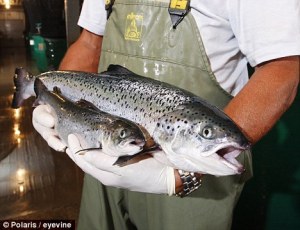
AquaBounty Technologies expects to grow GMO salmon (rear) bigger and faster than their non-GMO competitors (front).
Believe it or not, the feds have given the go-ahead to genetically modified salmon that will be grown in tanks in Panama from fish eggs produced on Prince Edwards Island. Expect to find these first GMO salmon — indeed the first GMO food critters of any kind — in supermarkets in about two years or so. The only problem is, you may not be able to tell the GMO fillets from the others, because the Food and Drug Administration is not requiring salmon grower Aqua Bounty to slap a GMO label on their AquAdvantage fish.
That could be because there is no apparent consumer demand for genetically engineered salmon, and there’s plenty of consumer concern that it could be bad for our health, the environment or both.
Consumer and environmental groups, which are already challenging the FDA ruling, argue that the safety studies are inadequate and that the health and quality of wild salmon could be threatened if the GMO fish escape into oceans and streams.
Wenonah Hauter, executive director of Food and Water Watch, said the FDA ruling “disregards the vast majority of consumers, many independent scientists, numerous members of Congress and salmon growers around the world who have voiced strong opposition.”
Aqua Bounty is apparently motivated by the profit potential of being the first to grow salmon bigger and faster through genetic engineering than their non-GMO competitors. But they may not wish to highlight the GMO status on their label.
Consumers who wish to avoid consuming GMO salmon should therefore steer clear of the “AquAdvantage- Aqua Bounty” label. With luck, the best wild salmon producers will be smart enough to slap a “non-GMO” label on their fish, to point out the difference.
To find the best information about wild salmon, or any other sustainable seafood, your most convenient source is Seafood Watch, whose website (seafoodwatch.org) and phone app will help you choose from what’s available at your fish market. Now that I have the app on my phone, I don’t have to guess which seafood is best for me. When I reach the fish counter, I just reach in my pocket, click on the Seafood Watch app, type in “salmon” or any other possibility available, and follow their advice, which is color coded: green (go), yellow (maybe OK) and red (no way).
–Dee Reid
Wild perennial pesto
The only crop that was ready to be harvested this week in my early spring garden was one I had nothing to do with. When I went out to the garden to check on my sugar-snap peas (they finally germinated!), imagine my delight when I also discovered a whole bed of chickweed and dead nettle. These delicious and nutritious wild, edible, perennial and ubiquitous greens had taken over a bed of soil that I had not yet planted.
What could be better? They grew on their own, with no help from yours truly. I didn’t have to buy seeds, nurture the transplants, weed, feed or fret about this crop. It just took care of itself, and in so doing, it is taking great care of me, too.
So I thanked Mother Nature and grabbed up several fistfuls to eat and cook with. I learned about this “manna” from heaven a couple of years ago when I went for a walk with the amazing herbalist and wild foods enthusiast Kim Calhoun, and later took a class with her at Central Carolina Community College. She showed me some of the weeds growing in our backyards that can easily be used in salads, soups and pesto.
She also told me that wild greens are packed with nutrients — or “goodiments” as she likes to say. Then she shared her recipe for Wild Greens Pesto, which also features garlic, one of the most nutritious cultivated foods we know.
I made my first batch of the season this week and it’s even more delicious than my last batch. It tastes great on sandwiches, pasta, vegetables, seafood, meats, etc. You can keep it in the refrigerator for weeks at a time (if you can manage not to gobble it all at once) and it keeps well in the freezer in individual ice cubes for easy future use.
Planty Kim’s Wild Greens Pesto
Ingredients:
3 medium garlic cloves
½ cup walnuts (or pecans, almonds, cashews, pine nuts)
3 cups firmly packed greens (any combo of seasonal wild & cultivated herbs—see list below)
¼-½ cup extra virgin olive oil
1 tablespoon lemon juice
1 tablespoon UME plum vinegar (or sea salt to taste)
1 tablespoon nutritional yeast (a dairy-free option instead of parmesan cheese)
Preparation:
1. Blend garlic and nuts in food processor until coarsely chopped.
2. Add remainder of ingredients to food processor and blend till desired smoothness. Yields approximately one cup.
3. Eat on crackers, mixed into pasta, smeared on a frittata or fried egg sandwich, spread on rolls or pizza, get creative!
4. Any leftovers will keep in the fridge for a week or more. I like to triple the recipe and freeze some Wild Green Pesto in half pint (8oz.) glass mason jars.
Wild Greens of the NC Piedmont in early Spring (to name a few): chickweed, purple dead nettle, creasy greens/cress, dandelion leaves, plantain leaves, tender yellow dock leaves, wild lettuce leaves, cleavers, wild garlic, self heal, violets,henbit…don’t forget flowers too—dandelion (remove bitter green base), henbit…
Cultivated Greens: parsley, cilantro, nettle, lemon balm, thyme, rosemary, nettle, oregano…
Before you pick something to eat, you should be sure you know what it is. Check online for color photos of these greens, or ask a friend who knows. Also be sure it’s growing in an area that is not polluted by chemical pesticides, herbicides or road runoff. Always wash the greens before consuming them, in case any of our four-legged friends “fertilized” them when we weren’t looking.
Feds okay GMO apple
Believe it or not, the U.S. Department of Agriculture has given the go-ahead to grow the first genetically modified apples. And they will not be labeled GMO.
Never mind that 175,000 consumers who commented on the proposal were overwhelmingly opposed. And that industry executives are not exactly salivating for Arctic Apples, the GM brand developed by Okanagan Specialty Fruits, a Canadian company.
Developers say their GM apples will not turn brown as quickly as other apples when sliced or bruised. Consumer groups say that’s not exactly compelling. They argue that genetically modified crops are not thoroughly tested for safety, and there could be unintended consequences associated with growing or consuming them.
“This G.M.O. apple is simply unnecessary,” said Wenonah Hauter, executive director of Food & Water Watch. “The USDA has let down U.S. apple growers and the public by wasting resources on this useless and risky food.” Apple browning is a small cosmetic issue that consumers and the industry have dealt with successfully for generations, she explained.
Environmentalists have been urging Big Food companies to reject the GMO apples. So far McDonald’s and Gerber have said they have no plans to use them.
Arctic Apples eventually will be available in the Granny Smith and Golden Delicious varieties. The only way consumers will be aware that they are genetically modified is if they know enough to look for the Arctic brand on the label.
A major concern of apple industry leaders is that Americans who love fresh apples for taste and health reasons may reject the bio-tech fruit, or all apples if they are unsure about their GM status. The news about the new GM apples could also hurt exports to countries that do not like or allow genetically modified foods.
“In the marketplace we participate in, there doesn’t seem to be room for genetically modified apples now,” said John Rice in a story on the New York Times business page. He is co-owner of Rice Fruit Company, in Gardners, Pa., which calls itself the largest apple packer in the East.
The USDA approval says that growing the GMO apples does not pose any harm to other plants or pests. The apples won’t be in grocery stores immediately, however, as the company awaits a voluntary safety review by the Food and Drug Administration (FDA).
Read more at Politico, New York Times and Food & Water Watch.
Women rock our foodshed
North Carolina ‘s widely recognized real-food scene is cultivated by hundreds of innovative chefs, farmers, advocates and entrepreneurs. A recent story in The New York Times noted that so many are women. Got that right.
Women are running the best professional kitchens across the state, reported Kim Severson. But there’s more. “The food sisterhood stretches out beyond restaurants too, into pig farming, flour milling and pickling,” she wrote. “Women manage the state’s pre-eminent pasture-raised meat and organic produce distribution businesses, and preside over its farmers’ markets. They influence food policy and lead the state’s academic food studies. And each fall, the state hosts the nation’s only retreat for women in the meat business.”
Turns out women lead in “every single link in the food chain in North Carolina,” said Margaret Gifford, who spent 16 years in the state and founded the nonprofit Farmer Foodshare (now directed by Gini Bell).
The Times feature cited amazing chefs including Andrea Reusing (Lantern), Ashley Christensen (Poole’s Downtown Diner and more), Katie Button (Asheville’s Curate and Nightbell), and Vivian Howard (Kinston’s Chef and the Farmer, and the PBS Show A Chef’s Life).
Other leaders include food studies professor Marcie Cohen Ferris (UNC), innovative pickler April McGreger (Farmer’s Daughter), baker Phoebe Lawless (Scratch), pork producer Eliza MacLean (Cane Creek Farm), meat distributor Jennifer Curtis (Firsthand Foods) and millers Jennifer Lapidus and Kim Thompson (Carolina Ground).
In our Pittsboro foodshed alone, we admire Debbie Roos, our sustainable agricultural extension agent and pollinator garden propagator. Also Slow Money NC co-founder Carol Hewitt, Abundance NC director Tami Schwerin, sustainable ag community college director Robin Kohanowich, Greek restaurateur Angelina Koulizakis-Bashista and a long list of female farmers, co-op leaders, food bank operators, and farmers’ market managers. Yow.
Men working in the food shed told The Times that it’s not surprising that women are leading the way. “For me, it’s as simple as the cream rises to the top,” said Chef Tandy Wilson (City House).
To read the full story: http://www.nytimes.com/2015/01/28/dining/a-food-sisterhood-flourishes-in-north-carolina.html?ref=dining&_r=0
Two farmers and a chef hatch pop-up dinners
By Dee Reid
What happens when two sustainable farmers and a chef decide to offer farm-to-fork dining at a biofuels plant in Pittsboro? That’s not a reality TV show pitch. It’s actually what took place on Saturday night when new Piedmont Biofarm co-owners Brett Evans and Will Carmines collaborated with new Chatham Chef Geoff Seelen to host their first hyper-local dinner at the Piedmont Biofuels Eco-Industrial campus on the edge of town.
Their synergy warmed our hearts and bellies, and ignited a unique locavore pop-up dining series that is sure to succeed.
Tickets for the first Piedmont Biofarm-to-Table Dinner sold out in two days. Some 30 guests paid $30 each to enjoy a tantalizing four-course meal in an impromptu festive dining space, just steps away from the vegetable beds that produced fresh ingredients even in mid-winter.
Just before dinner, we also got a chance to sample spirits infused with seasonal ingredients, at another fairly new venture, Fair Game Beverage, “Pittsboro’s only legal distillery.” Like the Biofarm, the distillery is also based at the Eco-Industrial Complex.
With a farm, distillery, kitchen, swing space and great parking on site, the complex is an ideal setting for community gatherings.
The seeds for the dinner series were first planted when Chef Geoff moved to Chatham from New York, where he had been working in the renowned Blue Hill restaurants.
“I met Will at one of the weekly community lunches,” Geoff explained. “And we began talking about this idea of joining forces to create special dinners.”
Will and Brett are excited to be carrying forward the sustainable ag vision of Doug Jones, who founded the Biofarm. He mentored his two former interns to take over the farm when he was ready to spend more time on other ventures, including cross-breeding new varieties of Pittsboro peppers. Now the Biofarm continues to successfully produce an abundant variety of vegetables with no synthetic chemical inputs.
The Menu
Saturday’s first course was a tasty mixed-greens salad featuring chard, Brussel sprout leaves, and radishes. That was followed by a lovely small plate of mini-crepes made with four varieties of roasted sweet potatoes drizzled with a squash-based sauce.
The main attraction was Chatham rabbit (from Fatty Owl Farm) — white meat cooked tenderly and served over a bed of warm greens and sun chokes, flavored by a rabbit-liver-based sauce enhanced with a Fair Game port. Yum. We cleaned our plates.
Geoff, Brett and Will decided to make their first dinner especially challenging by presenting it in January, the most difficult month for food production. They made it look easy, except for dessert. (No summer peaches or blueberries to fall back on.) They came up with a frozen dairy ice, topped with pulverized acorns and black walnuts harvested “right out back,” said Geoff. I enjoyed the creative and no doubt labor-intensive use of wild ingredients, but kept thinking a splash of warm Fair Game brandy might have taken it up just a notch on this cold night.
We’re glad they are ready to continue the series, perhaps monthly, though they expect to raise the price a bit, so that wait staff can be paid instead of working just for tips. Sounds reasonable, as long as it doesn’t get too pricey for eclectic locavores, whose enthusiasm at this dinner was almost as essential to the experience as the menu.
Seated at our end of the table were a young furniture craftsman who also plays classical piano, a future elementary school teacher, a massage therapist, a “slow money” advocate and a potter. We had plenty to talk about between bites, and that was half the fun.
Many thanks to Geoff, Brett, Will, Abundance NC, Fair Game Beverage and all who contributed to a special night out in PBO. We look forward to more.
State of the Union’s Food

You may also enjoy this classic guide to conscious eating through simple, conscious cooking ala Bittman
The state of the union food-wise is not good, says our favorite New York Times food columnist Mark Bittman. No kidding. That’s why it’s long past time for a National Food Policy.
After all, 15% of Americans (that’s 46.5 million people) are subsisting on SNAP benefits (food stamps). And you can bet that most of them are not getting enough fresh, healthy food with their food stamps, and that many suffer from, or are at fisk of, costly diseases that can be caused by poor nutrition: obesity, Type 2 diabetes and hypertension.
Come to think of it, Bittman says, many of our domestic challenges are connected one way or the other with food.
“You can’t address climate change without fixing agriculture,” he says. “You can’t fix health without improving diet, you can’t improve diet without addressing income, and so on. The production, marketing and consumption of food is key to nearly everything. (It’s one of the keys to war, too, because large-scale agriculture is dependent on control of global land, oil, minerals and water.)”
Here are Bittman’s top policy recommendations:
- Get antibiotics out of our food supply.
- Tie reducing greenhouse gas emissions to reining in the industrial production of animals for meat.
- Support strong front-of-package food labeling.
- Defend the menu labeling mandated under the Affordable Care Act.
We like his list and have a few more suggestions:
- Increase financial support for farmers, businesses and organizations that produce and distribute fresh, healthy, local food.
- Decrease subsidies and incentives to farmers, businesses and organizations that produce, advertise, and distribute unhealthy food, especially to children.
- Increase the minimum wage of food workers for farms, food processing plants, restaurants, grocery stores, etc.
It’s a start. To read the rest of Bittman’s thoughtful comments on national food policy, click here. Feel free to share your recommendations.
Farm to Food Bank: Feeding the hungry in a land of plenty
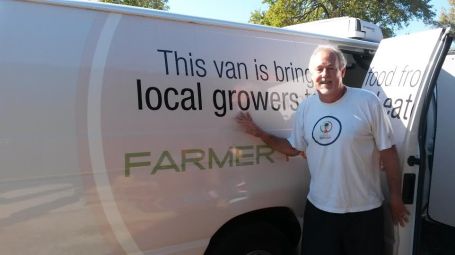
Farmer Foodshare driver Ryan Cribbins delivers fresh farm produce to food agencies serving hungry clients in four counties
By Dee Reid
For most foodies the Triangle is a locavore paradise teeming with family farms, fresh markets and seasonal cuisine. But despite this cornucopia, more than 16 percent of our regional neighbors (276,000 adults and children) are considered “food insecure.” Struggling to make ends meet, they know what it means to be hungry. Many rely on cheap processed food that is high in fat and sodium. And that increases their risk for Type 2 diabetes, hypertension, obesity and other costly ailments related to poor diets.
Farmer Foodshare is breaking new ground to tackle this paradox of hunger in a land of plenty. The Durham-based nonprofit has established a centralized food hub called the POP (Pennies on the Pound) Market. Its staff and volunteers purchase fresh food wholesale from local farms, then sort and deliver it at affordable :prices to an impressive web of local organizations that feed some 24,000 hungry people annually.
The idea is to strengthen local farms and local communities by providing new outlets for farmers and a convenient source of fresh healthy food for people who need it.
“Our goal is to keep it affordable for the food agencies, while ensuring that the farmers are getting a good price,” said POP Market manager Karla Capacetti.
That’s a tall order, which requires balancing tight schedules and budgets to meet the needs of a complex network of partners. The POP Market taps about 43 small-to-mid-size farms across 17 counties, and 25 local food banks, senior centers, preschools and other agencies feeding Alamance, Chatham, Durham and Orange counties.
The POP Market provides the efficiency, agility and “glue” needed to acquire and transport fresh food expeditiously to a diverse array of customers. Twice a week, Karla e-mails, texts and calls the farmers to find out what they have available. Then she e-mails a list to the food agencies, which have 24 hours to complete their orders. She assembles purchase orders and invoices, then e-mails them to two drivers, and gets them on the road to quickly pick up the bulk food from the farms, transport it to Farmer Foodshare to be sorted for customized orders, and re-load it into the van for direct delivery to the food agencies.
Together, the POP Market and its partner farms and agencies are now providing fresh local food to at least 500 people every week, year-round.
“It’s great to have all of this fresh food going to hungry people,” said Karla.
Since its formation in 2012, the POP Market has spent more than $150,000 with local farmers, and delivered 110,000 pounds of healthy food to local organizations. The program’s reach is growing rapidly. Since the beginning of this year alone it has purchased $83,000 from local farmers and delivered 60,000 pounds of food to local communities.
I recently rode in the Farmer Foodshare van as it traveled across the Triangle to fulfill the message emblazoned on its door panels, “bringing food from local growers to local eaters.”
Jerry Levit, a volunteer and retired farmer and realtor, was delivering farm goods to seven agencies spanning three counties. By 9 am he had picked up produce from Farmer Foodshare and delivered the customized orders to Child Care Services and Chapel Hill Daycare. I caught up with him at Evergreen United Methodist Church in north Chatham, which houses the Take and Eat Food Pantry. The pantry, supported by six local churches, provides groceries for 30-40 families per week.
Pantry manager Michelle Morehouse especially likes supplementing the non-perishables with fresh local food. “My goal was to improve the nutritional content of the food we give out,” she said. “Now we can order healthy produce based on our clients’ preferences.”
The families that come to the pantry also enjoy having fresh produce, even unfamiliar items. “Many clients have never tried some of these vegetables before,” Michelle said. “They discover they like them and they let us know that.”
Jerry went on to deliver more fresh food to four other partner organizations that day, including Sonder Market, a new student-run produce stand at UNC; the Inter-Faith Council Food Pantry in Carrboro; nearby Club Nova, providing mental health support programs; and Child Care Services in Durham.
Jerry likes supporting farmers and helping them expand their reach to needy customers. “We’re committed to strengthening sustainable agriculture and feeding the people,” he said.
The following day I rode with Ryan Cribbins, a part-time POP Market employee who has retired from a long career at RTI International. We drove to the State Farmers’ Market where we picked up fresh produce from three growers: Cox Farms in Goldsboro, Wise Farms in Mt. Olive and Jones Farm in Snow Hill. Then we drove to Lyon Farms in Creedmoor. In just three hours, Ryan had filled the van to capacity with about $1,200 worth of squash, sweet potatoes, strawberries and grapes.
The farmers were pleased. Robbie Cox drove a front loader with more than $500 worth of produce over to the Farmer Foodshare van, including a dozen boxes of cucumbers, five bushels of yellow onions, two bushels of red bell peppers and a big box of broccoli.
“This system works well for us,” said Robbie, who has been farming all of his life. “We can provide quantity and top-of-the-line produce. And every bit of what we can sell helps our bottom line.”
Back at Farmer Foodshare’s warehouse, Ryan unloaded the van, then labeled boxes for next-day delivery to four partner organizations: Veggie Van, a local mobile market; TABLE, feeding school children; Panda Packs, providing week-end food for hungry students at Pittsboro Primary School; and the Interfaith Council Food Pantry in Carrboro.
“I love what we’re doing,” said Ryan. “It’s a really good organization and I like contributing to something worthwhile. I’m also learning a lot about our farm system and the food agencies that serve our communities.”
Fertilizing a food desert
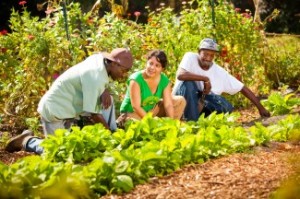 An urban farm and community garden has sprouted at 500 Hoke Street in southeast Raleigh. Though it’s only two miles from the capital’s trendy eateries, the Inter-Faith Food Shuttle farm is at the heart of a “food desert.”
An urban farm and community garden has sprouted at 500 Hoke Street in southeast Raleigh. Though it’s only two miles from the capital’s trendy eateries, the Inter-Faith Food Shuttle farm is at the heart of a “food desert.”
Most of its neighbors can’t afford to dine upscale downtown. And there’s no supermarkets nearby where they can find healthy groceries for their families. Urban food deserts typically rely on fast-food joints and convenience stores, where calories are cheap but not necessarily nutritious. That’s a recipe for the growing incidence of obesity, Type 2 diabetes and other costly ailments related to poor diets.
Hoke Street turned out to be an ideal location for the urban farm and training center for Inter-Faith Food Shuttle, the anti-hunger nonprofit serving Raleigh and seven surrounding counties for the last 25 years. The new three-acre site now includes community garden beds for residents wishing to grow their own produce, and an urban farm and training center for interns learning to cultivate and sell healthy food.
“We set up this space so people could see how food is grown, and grow it themselves” said Katie Murray, who coordinates IFFS urban agriculture training programs. We visited during the Carolina Farm Stewardship Association’s annual farm tour.
Half a dozen families are growing vegetables in the new IFFS community garden. And there’s an open raised bed for curious neighbors who want to taste what’s sprouting — red leaf lettuce when we visited. IFFS also has cultivated a partnership with Will Allen, the now-famous MacArthur Foundation “Genius” Fellow behind Growing Power, the organization teaching young people around the country about innovative sustainable practices for urban farming enterprises. IFFS has four interns through the program, working at the Raleigh farm and learning about composting, vermiculture, aquaponics, hoop houses, mushrooms, micro-greens and more.
“The goal is to grow food here and sell it through local farmers’ markets and to restaurants,” Murray said. The interns are gaining experience to develop their own small enterprises through a collaborative local alliance.
The farm is adjacent to a 14,000 square-foot warehouse, where IFFS stores local food gleaned from farms and delivers it to neighborhoods through its mobile market program. The IFFS warehouse also serves as a community grocery store during a monthly market on fourth Fridays.
Inter-Faith Food Shuttle also has a Teaching Farm on Tryon Road, with incubator plots for those ready to start their own farming enterprises.




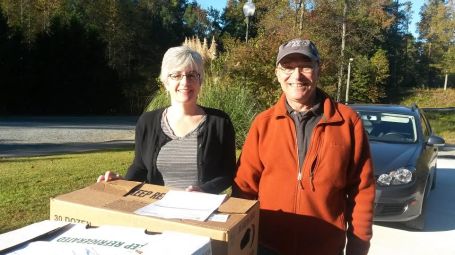

My Plate, My Planet
I’m happy to add our support to this open letter, and urge you to add your support at http://www.myplatemyplanet.org
Food for a Sustainable Nation: An Open Letter to HHS Secretary Sylvia Mathews and Agriculture Secretary Tom Vilsack
As Americans, we rely on our government to provide accurate, science-based information, that promotes the health of our families and our environment.
Share this:
March 24, 2015 at 1:08 pm Dee Leave a comment